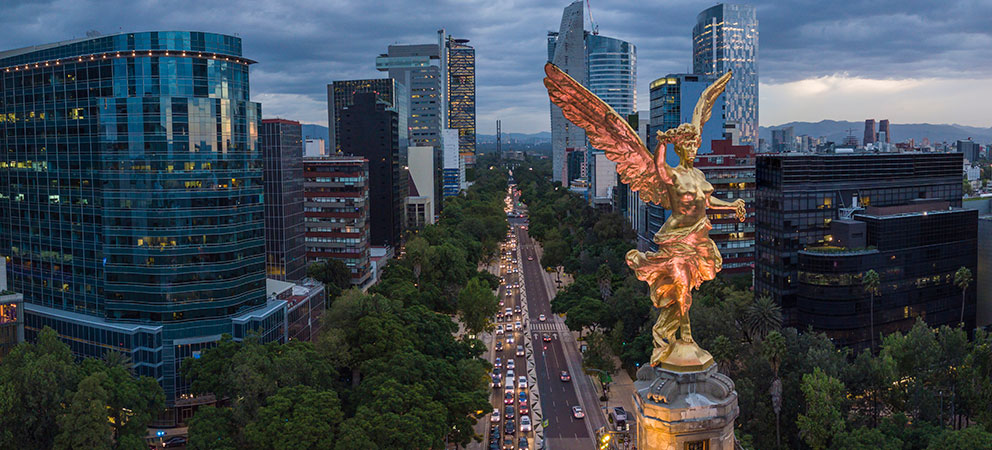
Mexico’s economic growth picks up, but outlook weakens
May 23, 2022
| May 2022 economic report | |||
| GDP, real January–March '22 |
Employment, formal April '22 |
CPI April '22 |
Peso/dollar April '22 |
| 3.6% q/q | 97,000 jobs m/m | 7.6% y/y | 20.1 |
Mexico’s GDP grew an annualized 3.6 percent in first quarter 2022, an increase from fourth quarter’s dismal 0.1 percent growth. Nevertheless, first-quarter GDP growth was below analysts’ expectations of 4.6 percent. Mexico’s GDP outlook for 2022 continues to deteriorate, mainly due to the deceleration in global economic growth, ongoing supply-chain bottlenecks, higher inflation and tighter monetary policy. The consensus forecast for 2022 GDP growth, compiled by Banco de México, fell again in April to 2.1 percent (fourth quarter/fourth quarter) (Table 1). Inflation increased further as a result of price pressures associated with energy and commodities.
| Table 1: Consensus Forecasts for 2022 Mexico Growth and Inflation | |||
| April | March | ||
| Real GDP Growth (Q4/Q4) | 2.1 | 2.3 | |
| Real GDP (average year/year) | 1.7 | 1.8 | |
| CPI (Dec. '22/Dec. '21) | 6.8 | 5.8 | |
| Exchange rate—pesos/dollar (end of year) | 21.1 | 21.3 | |
| NOTE: CPI refers to consumer price index. The survey period was April 22–28. SOURCES: Encuesta sobre las Expectativas de los Especialistas en Economía del Sector Privado: Abril de 2022 (communiqué on economic expectations, Banco de México, April 2022). |
|||
The latest data available show that industrial production, exports, retail sales and employment grew, while remittances declined. In April, the peso gained value against the dollar, but inflation remained elevated.
Output Grows in First Quarter 2022
According to preliminary estimates, Mexico’s first-quarter GDP grew an annualized 3.6 percent (Chart 1). Both the goods-producing sector (manufacturing, construction, utilities and mining) and service-providing sector (wholesale and retail trade, transportation, business services) grew 4.4 percent, while agriculture output decreased 7.6 percent.
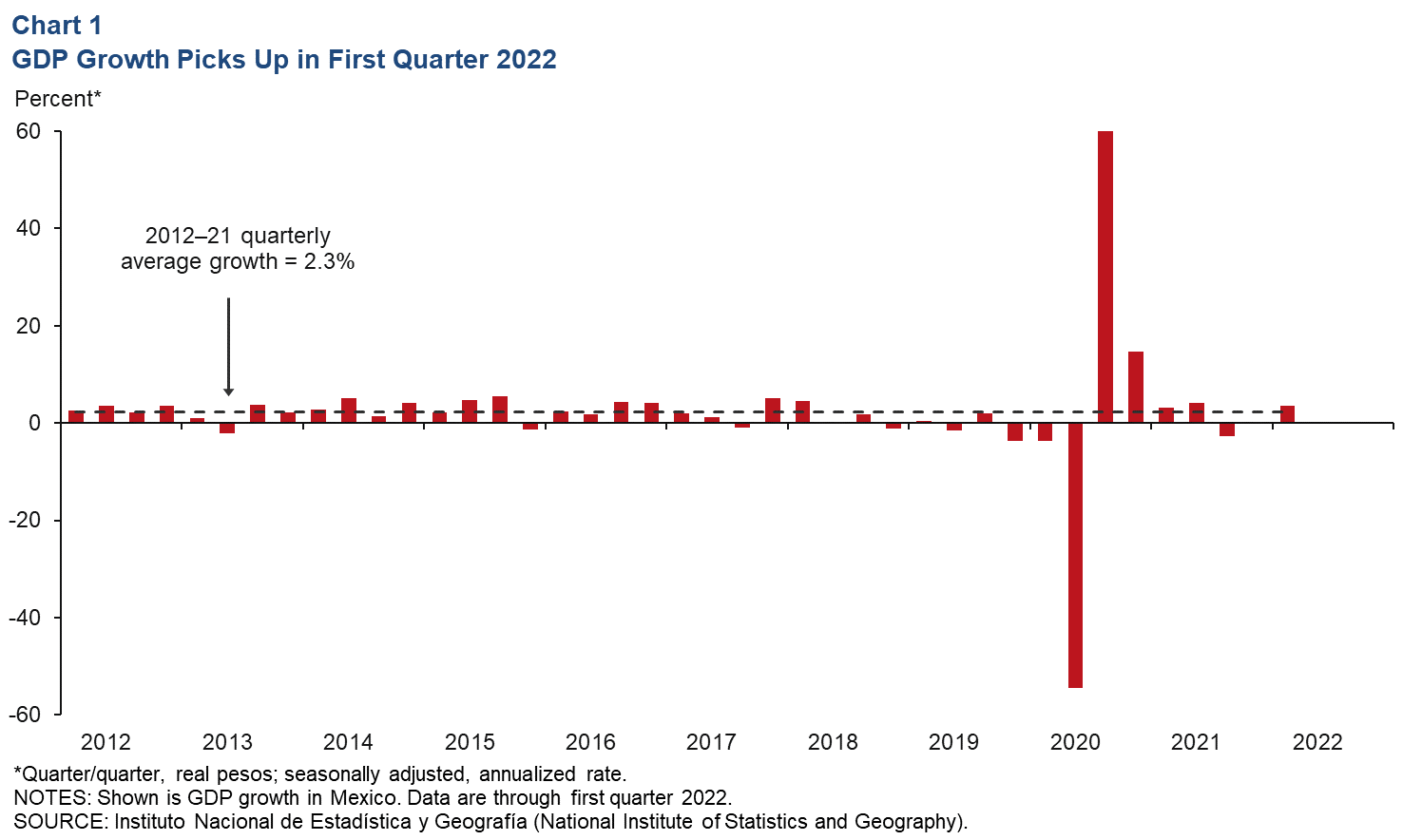
Industrial Production Expands
The three-month moving average of Mexico’s industrial production (IP) index—which includes manufacturing, construction, oil and gas extraction, and utilities—improved in March from February (Chart 2). On a month-over-month and unsmoothed basis, IP was up 0.4 percent in March. North of the border, U.S. IP increased 1.1 percent in April after rising 0.9 percent in March. The correlation between IP in Mexico and the U.S. increased considerably with the rise of intra-industry trade between the two countries since the early 1990s. Mexico’s manufacturing sector could experience some slowdown in the second quarter, particularly if U.S. consumer demand decelerates as a result of rising prices and higher interest rates.
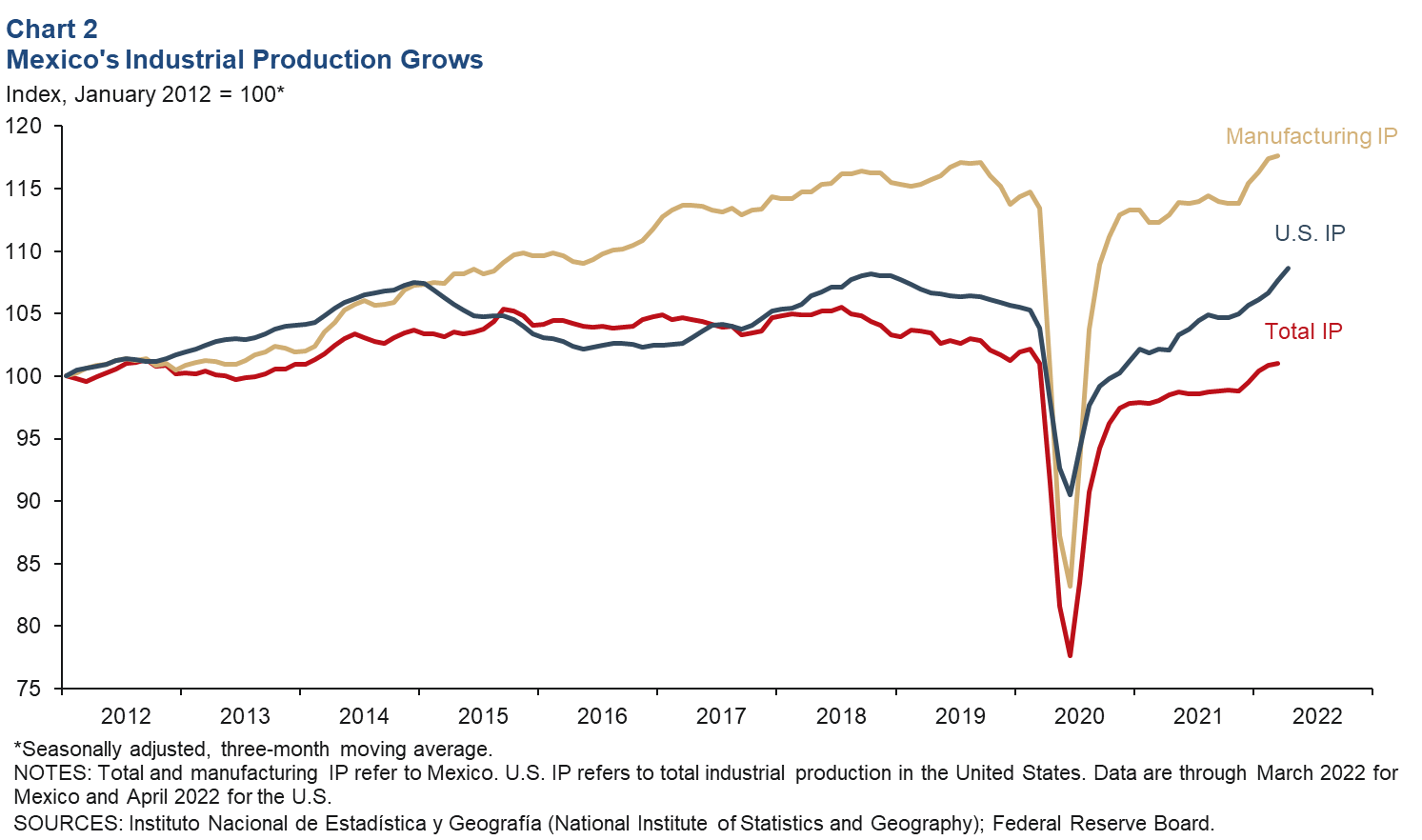
Exports Gain Momentum as Oil Prices Rise
The three-month moving average of total exports increased 1.2 percent in March as oil exports grew 9.2 percent and the much-larger manufacturing exports category grew 0.7 percent (Chart 3). On a month-over-month and unsmoothed basis, total exports declined 3.9 percent in March as oil exports grew 13.7 percent but manufacturing exports fell 5.1 percent. The pickup in oil prices has contributed to the recent growth in oil exports given that Mexico’s oil production has been flat since mid-2021. Mexico’s total real monthly exports in March were 12.8 percent above prepandemic levels (February 2020) and 9.7 percent higher than 12 months prior.
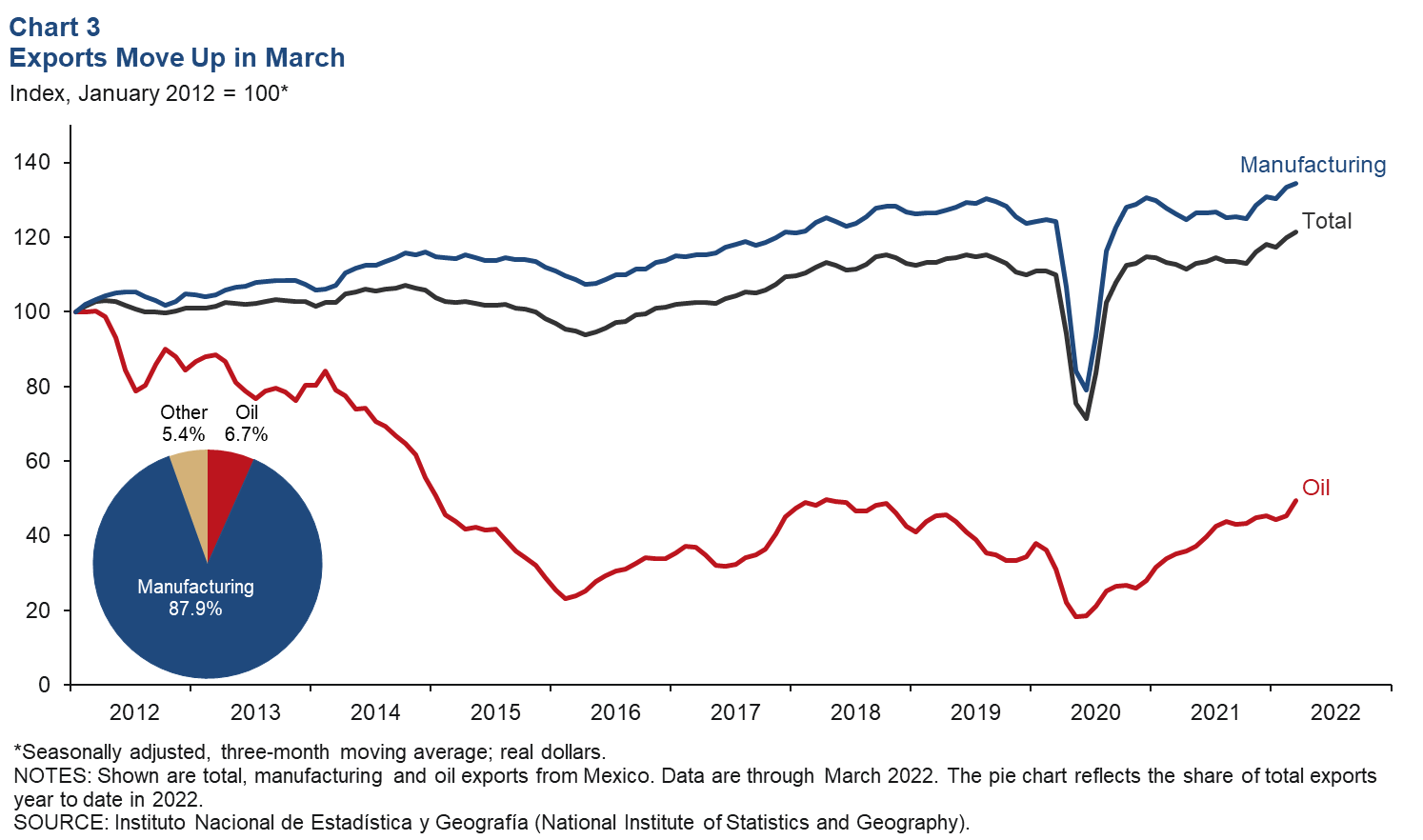
Retail Sales Grow
The index of real Mexico retail sales increased 0.6 percent month over month based on a three-month moving average through February (Chart 4). On a month-over-month and unsmoothed basis, retail sales grew 0.8 percent in February—the same rate as in January. Retail sales reached prepandemic levels (February 2020) in October 2021.
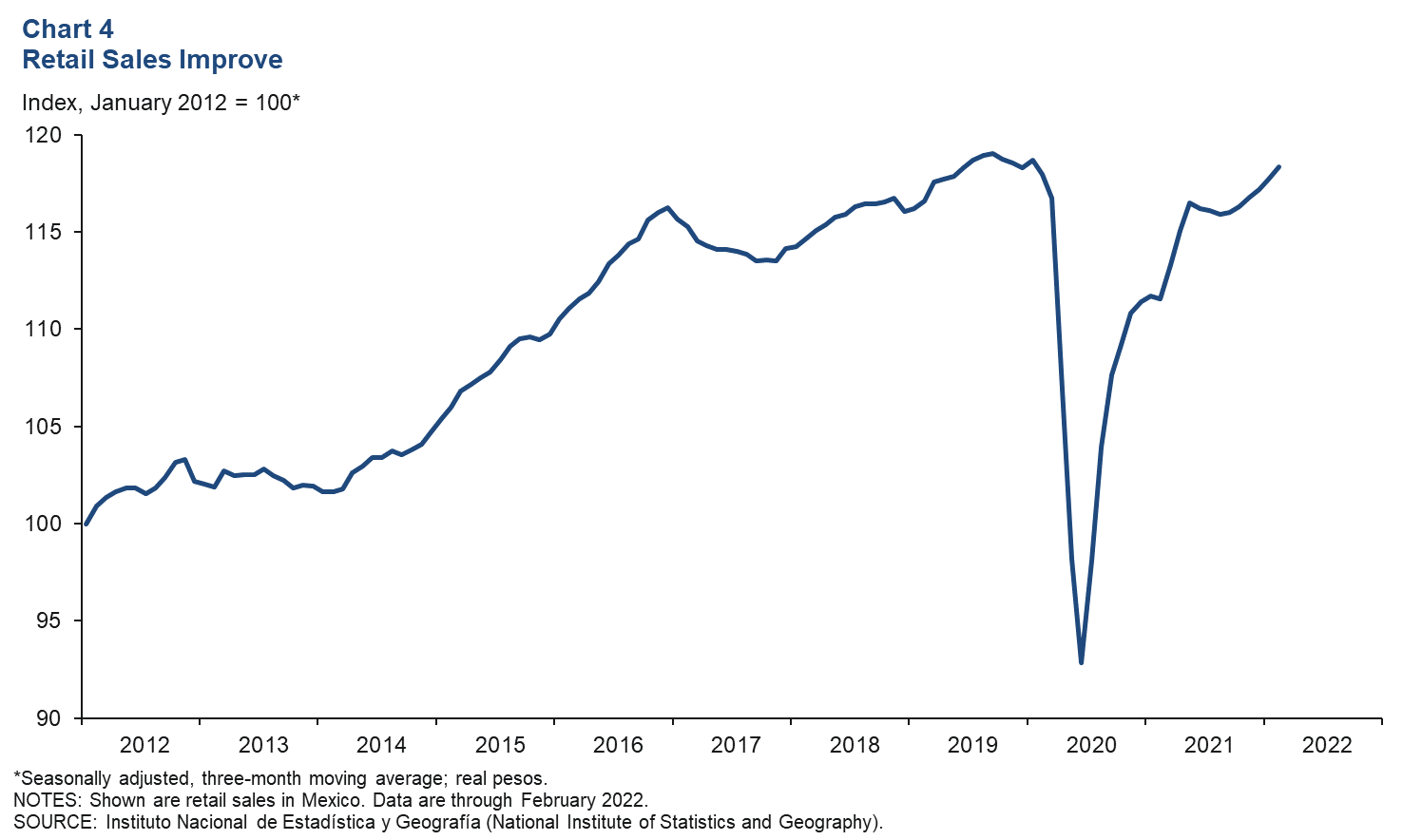
Payrolls Expand in April
Formal sector employment—jobs with government benefits and pensions—grew an annualized 5.7 percent (97,000 jobs) in April after increasing 5.1 percent in March (Chart 5). Year-over-year employment growth was 4.7 percent in April. Total employment, representing 56.6 million workers and including informal sector jobs, was up 6.2 percent year over year in fourth quarter 2021. The unemployment rate in March was 3.5 percent, down from 3.7 percent in February. Employment in Mexico recovered to prepandemic levels in September 2021, although GDP remains 1.6 percent below its prepandemic level.
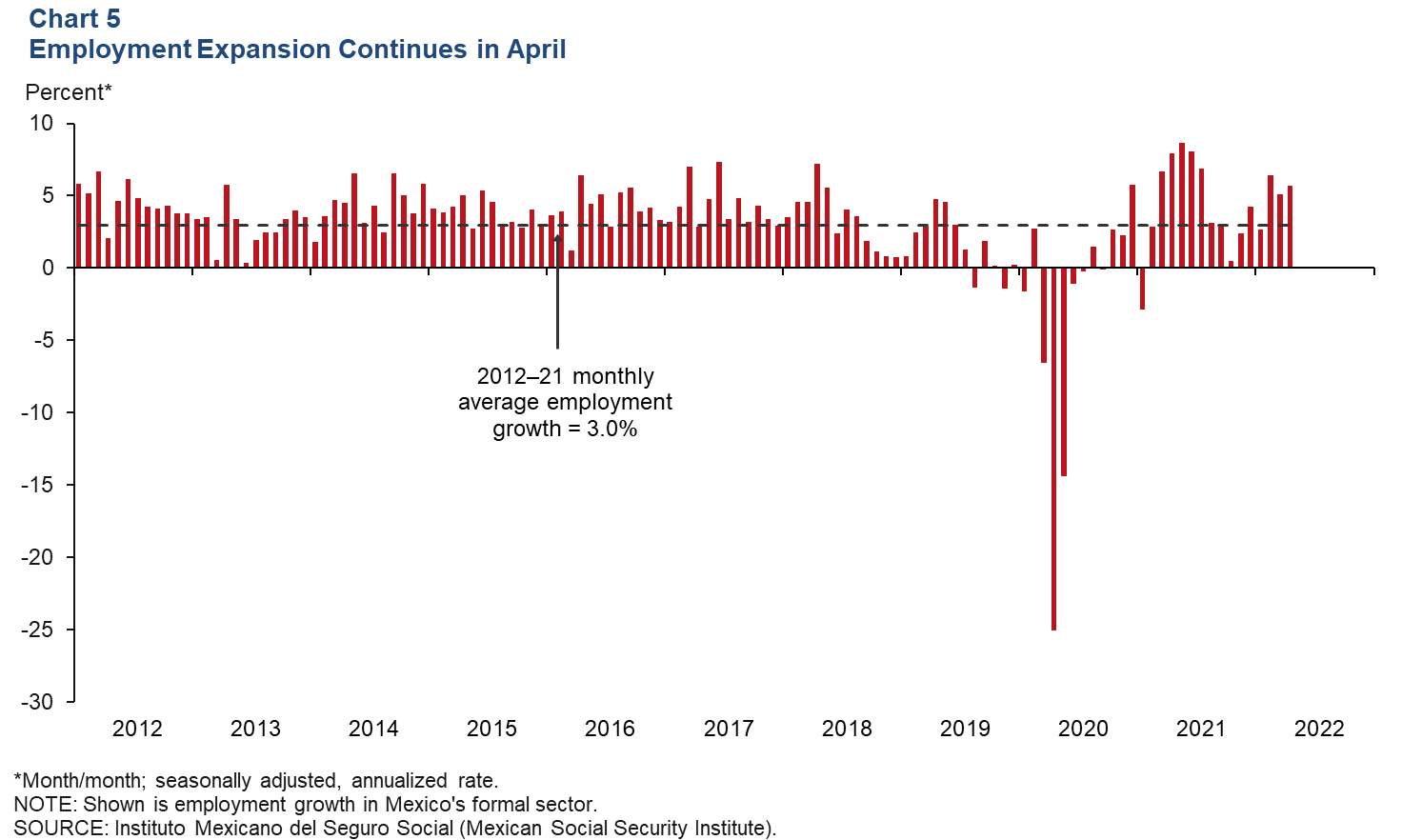
Peso Gains Some Ground Against the U.S. Dollar
The Mexican currency averaged 20.1 pesos per dollar in April, up slightly from March (Chart 6). However, the peso is still down 6.3 percent from its prepandemic level in February 2020. The peso has been under pressure due to high inflation and increased uncertainty regarding domestic and global growth.
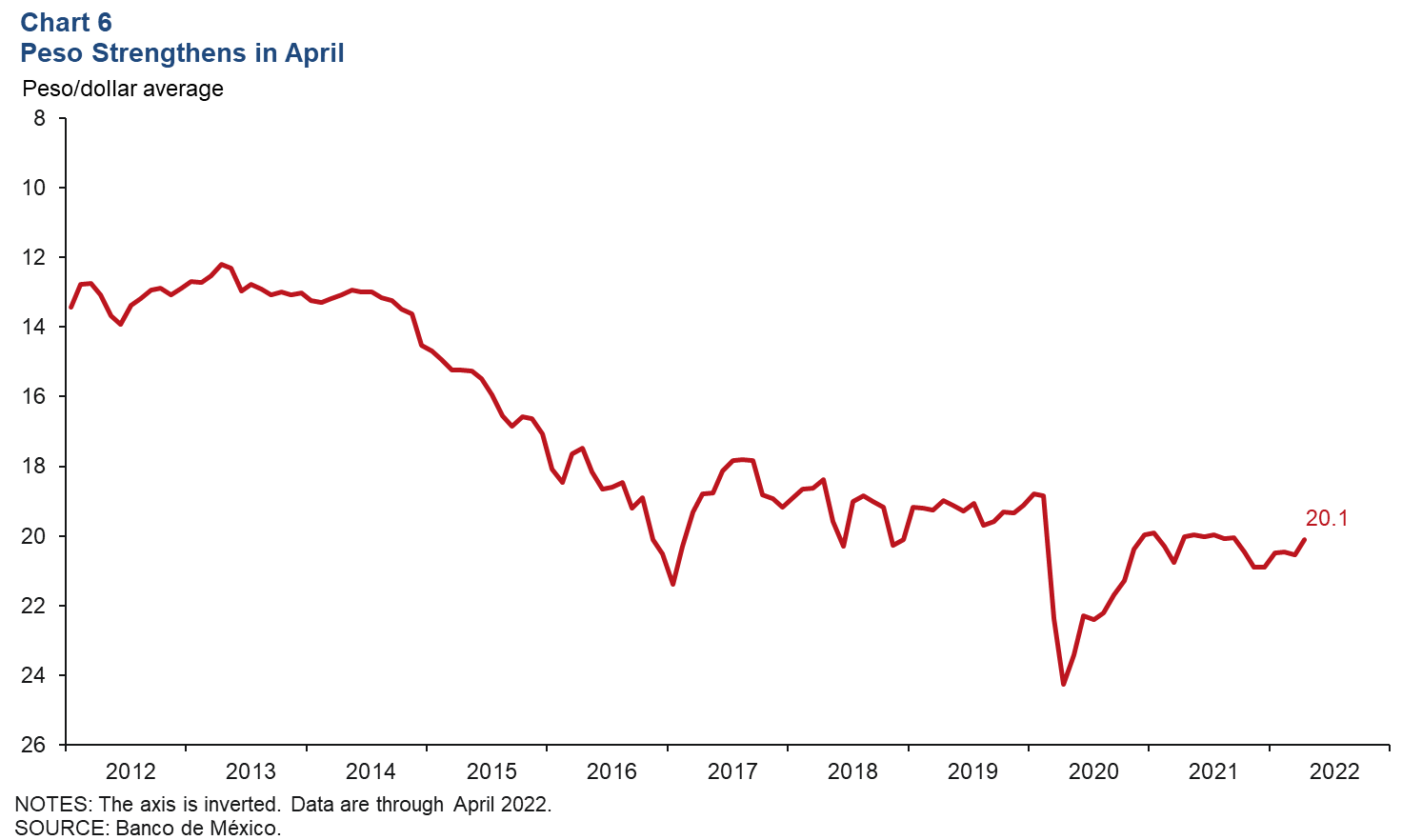
Remittances to Mexico Falling in 2022
The three-month moving average of real remittances to Mexico declined for the third consecutive month in March, falling 2.4 percent from February (Chart 7). On a month-over-month and unsmoothed basis, remittances fell 4.2 percent. Most likely, remittance flows to Mexico are slowing due to high inflation in the U.S. and elsewhere, which erodes disposable income, including funds for remittances. Remittances to Mexico peaked in November 2021. Depreciation of the peso between February and April of 2020 contributed to record transfers of $50 billion in 2021—as did Mexican migrants abroad sending more money to help relatives buy food or cover basic expenses during the pandemic.
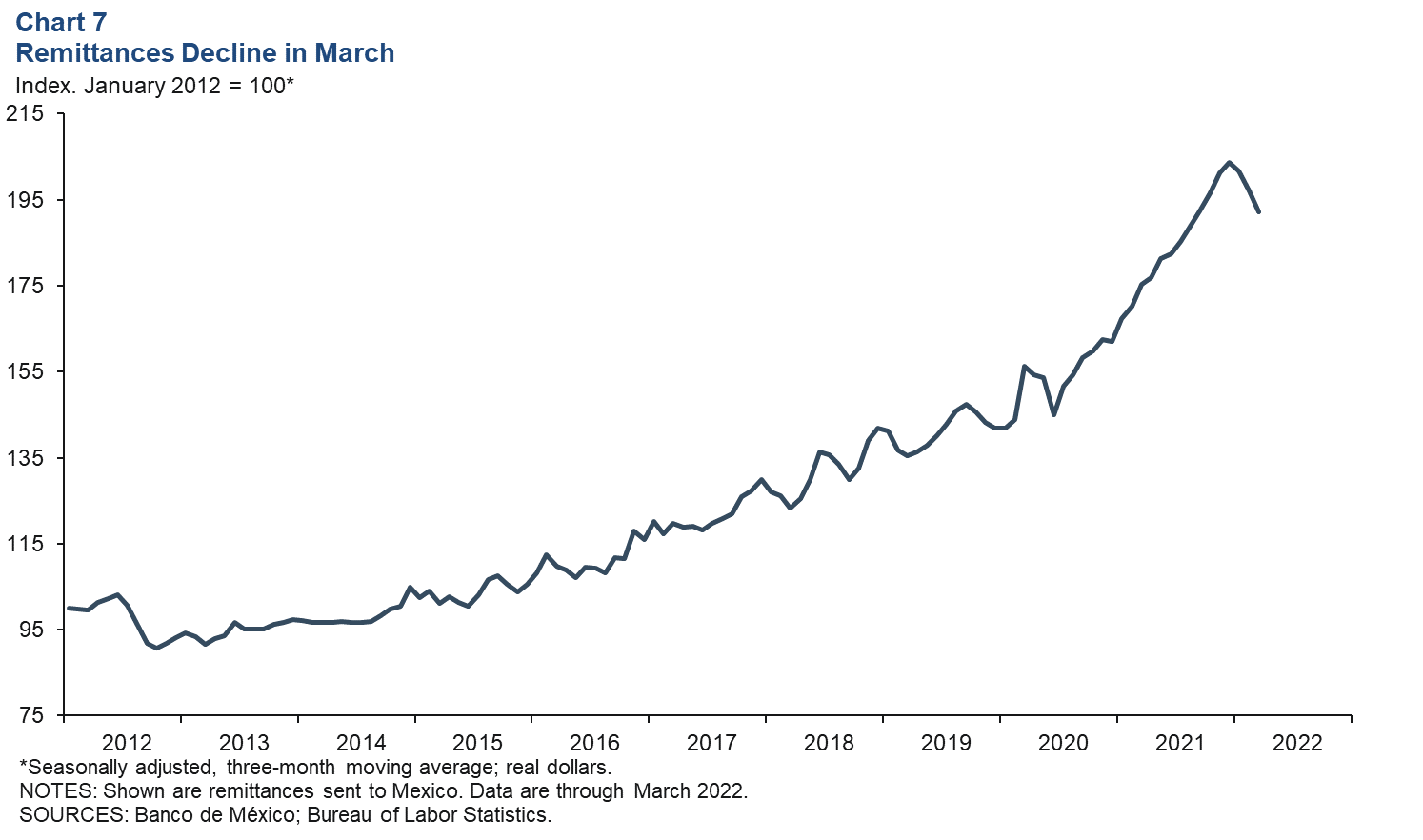
Foreign-Owned Government Debt Share Ticks Down
The three-month moving average of foreign‐owned Mexican government securities decreased to 17.7 percent in April, down 1.2 percent from its March value (Chart 8). The extent of nonresident holdings of government debt is an indicator of Mexico’s exposure to international investors and a sign of confidence in the Mexican economy. It’s noteworthy that the measure has been on a downward trend since peaking in early 2015.
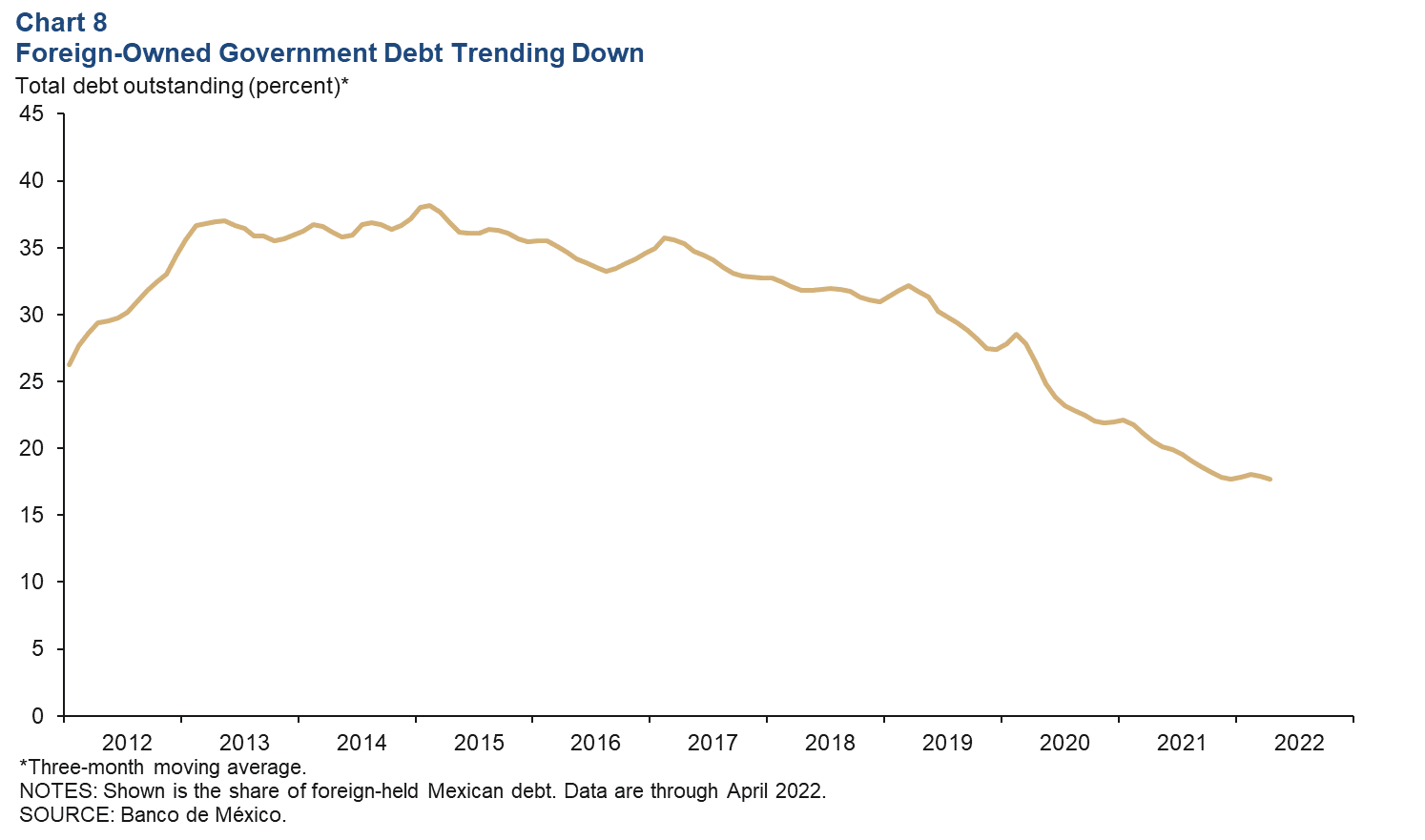
Inflation Increases Further
Mexico’s consumer price index (CPI) was up 7.6 percent in April over the prior 12 months, rising at a slightly faster pace than in March (Chart 9). CPI core inflation (excluding food and energy) rose 7.1 percent in April over the previous 12 months. In May, Mexico’s central bank increased the benchmark interest rate to 7 percent, hiking it by 50 basis points for the fourth straight time since December. In the public announcement accompanying the interest rate decision, the central bank cited several factors for the increase, including persistent global and domestic inflationary pressures associated with the pandemic; increases in energy, agricultural and livestock product prices; and the intensification of geopolitical turmoil.
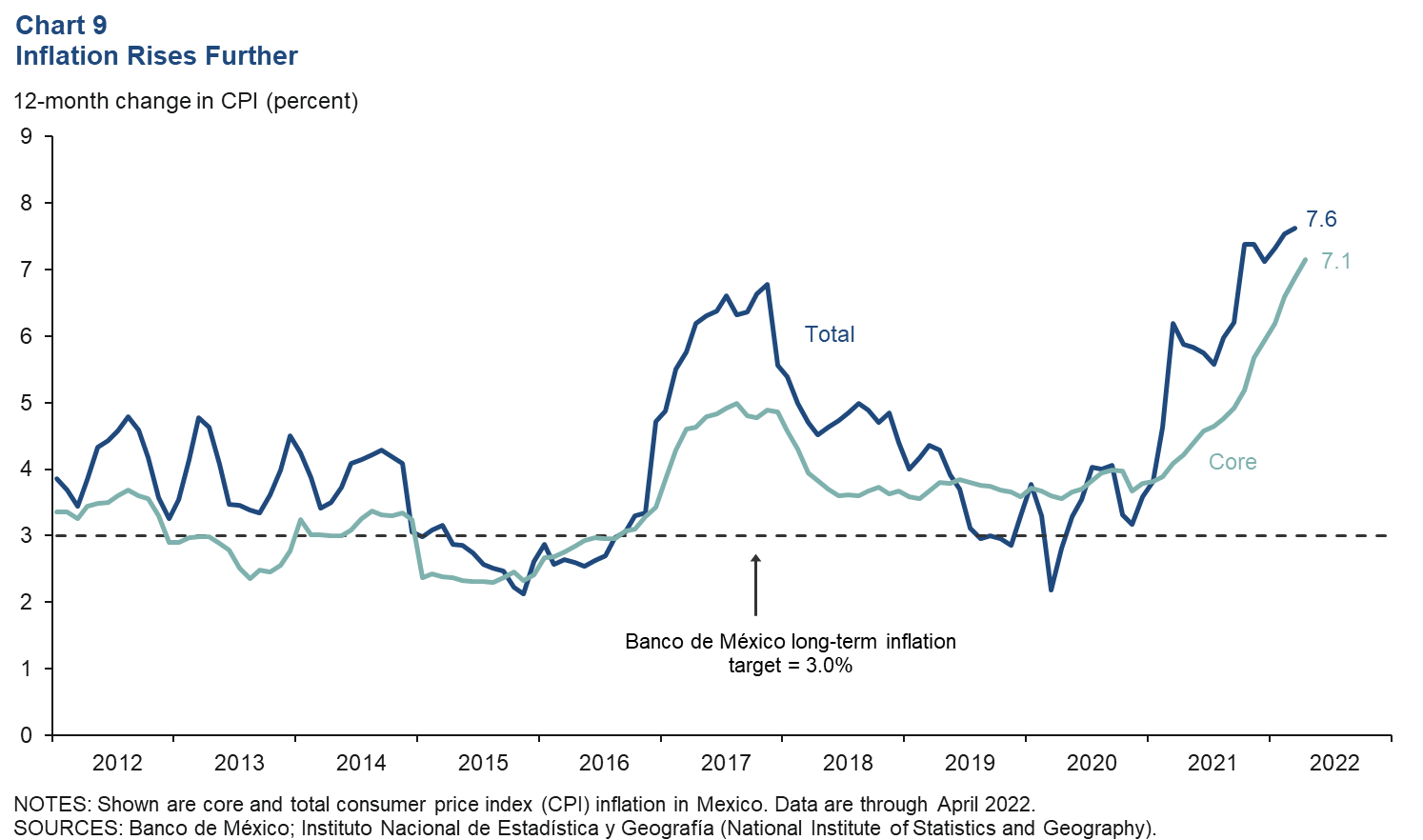
About the Authors
The views expressed are those of the authors and should not be attributed to the Federal Reserve Bank of Dallas or the Federal Reserve System.

